4G/5G access network solution
A Radio Access Network (RAN) is the part of a telecommunications system that connects individual devices to other parts of a network through radio connections. A RAN resides between user equipment, such as a mobile phone, a computer or any remotely controlled machine, and provides the connection with its core network. The RAN is a major component of wireless telecommunications and has evolved through the generations of mobile networking leading up to 5G.
The term radio access network (RAN) has been in use since the beginning of cellular technology and has evolved through the generations of mobile communications (from 1G up to 5G today). Components of the RAN include a base station and antennas that cover a given region depending on their capacity, plus required core network items.
1-BTS mobile base station solution
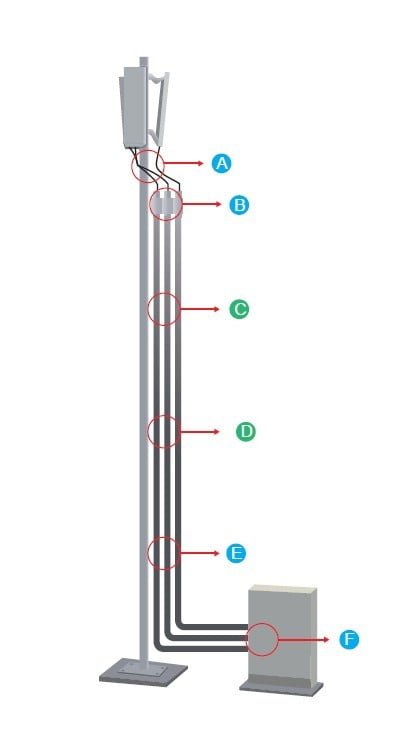
Transmission Line
A. RF Jumper
B. RF Connector
E. Feeder
F. Surge Arrester
Accessories
C. Grounding kit
D. Feeder Clamp
Base Transciever Station (BTS)
The BTS is a telecoms infrastructure used to facilitate wireless communication between subscriber device and telecoms operator network. The subscriber device can be mobile phone, wireless internet devices while the operator network could be a GSM, CDMA or TDMA platform.
A typical BTS comprises of a Transceiver (TRX) which handles transmission and reception of signals; sending and reception of signals to or from higher network entities, a Combiner which Combines feeds from several TRXs so that they could be sent out through a single antenna thus reducing the number of antennas that need be installed, a Power amplifier which aids in signal amplification from TRX for transmission through the antenna, a Duplexer which is used for separating sending and receiving signals to or from the antenna and an Antenna which is an external part of the BTS.
The BTS equipment are usually housed in a shelter which protects the telecoms equipment from external conditions such as dust, corrosion, rust, theft etc.
The shelter thus comprises of the BTS equipments already mentioned, an air conditioner which is used to cool the space as a result of the heat generated by the equipment, a battery bank that supplies the equipment with electrical power and security lights.
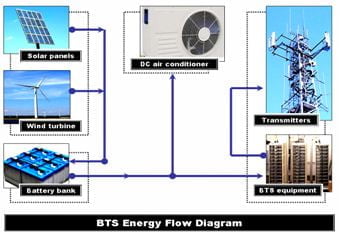
The energy demand of a telecommunication equipment differs according to its network specifications.(Table 1). Presently, 77% of 5.4 billion global cellular subscribers are on the GSM platform (Figure 2).
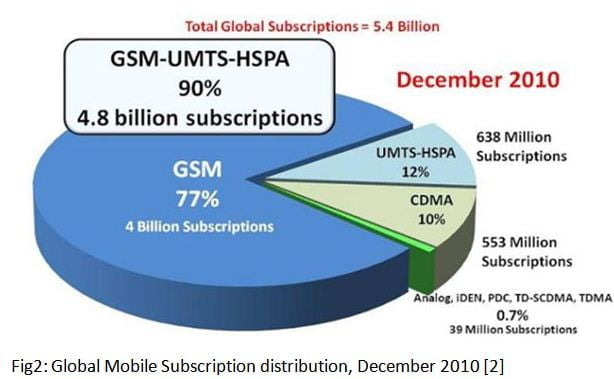
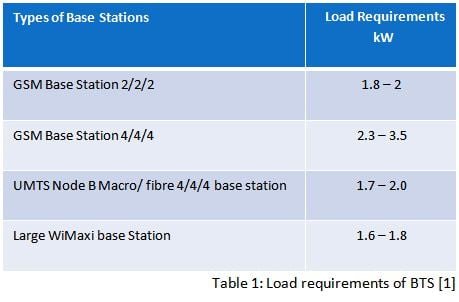
The temperature of the telecoms shelter during operation exceeds 55 degrees celsius which is a bad operating condition for the BTS electronic equipment. This necessitates the need for an air conditioner especially in the tropics to maintain the shelter temperature at 25 degrees celsius in order to prolong the shelf life of both the BTS equipment and the batteries.
The relative humidity is also of prime concern and as such it is maintained below 60% to avoid condensation of fluid (water) on the equipment. In most cases, the air conditioner serves a dual function of cooling and dehumidifying for the purpose of maintaining the acceptable humidity levels.
2-Distributed base station solution
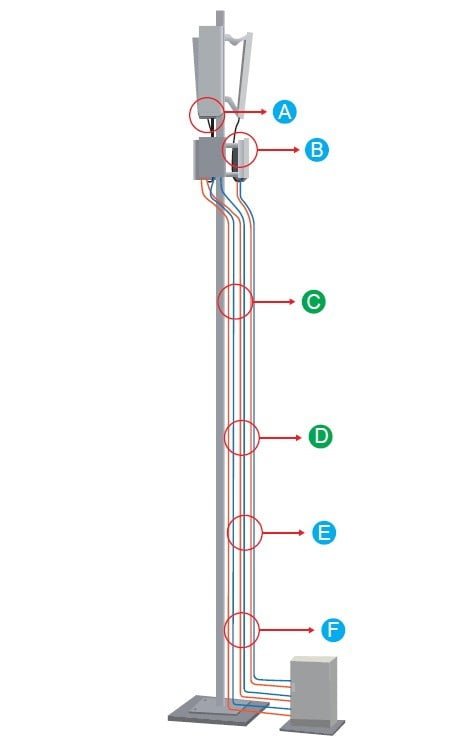
Transmission Line
A. AISG Jumper
B. RF Jumper
E. Optic Jumper
F. DC Power Cable
Accessories
C. Power Cable Grounding kit
D. Power and Optic Clamp
Distributed Base Stations enable radio access for small to large eLTE wireless private networks that provide services such as video surveillance, data acquisition, and data transmission. The base stations’ modular platform consists of a Base Band Unit (BBU) and Remote Radio Unit (RRU). Both components feature flexible installation, easy site deployment, low power consumption, and low TCO.
A typical wireless base station consists of the base band processing unit (BBU) and the RF processing unit (remote radio unit – RRU). The BBU is placed in the equipment room and connected with the RRU via optical fiber. The BBU is responsible for communication through the physical interface.
The main change in 5G is that the original Base Band Unit (BBU) in 4G/LTE is 5G is now split into three parts as defined in TR 38.801: Central Unit (CU) Distributed Unit (DU) Remote Radio Unit (RRU)
3-Photoelectric composite cable base station solution
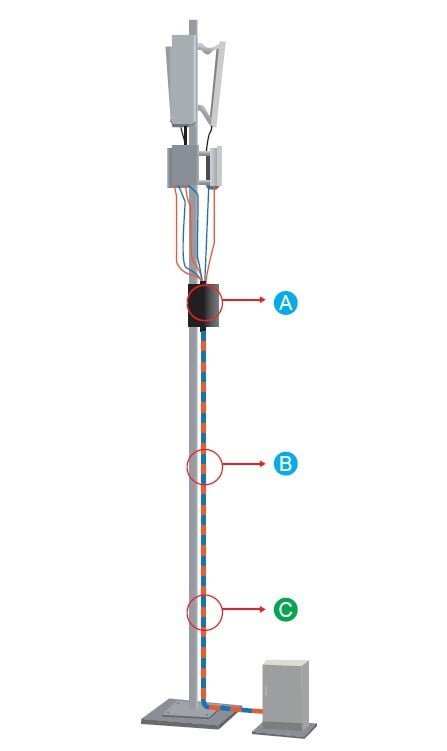
Transmission Line
A. HTTA Box
B. Hybrid Cable
Accessories
C. Hybrid Clamp
Hybrid Fiber Optic Cable, also called Photoelectric Composite Cable, is a new access method for communication access network system, which combines transmission copper wire with optical fiber, it can solve the problems of broadband access, equipment power consumption and signal transmission synchronously, so it is concerned by all communication operators.
The obvious advantages of Photoelectric Composite Cable are: (1) providing high bandwidth access while solving the problem of power consumption of equipment in network construction; (2) having a small outer diameter, lightweight and small occupied space; (3) having excellent bending performance and good resistance to lateral pressure, construction convenience.
However, there are some limitations of the Photoelectric Composite Cable, such as (1) in the current standard, the installation of the cable is following the “no electricity” or “weak electricity” standard, the Photoelectric Composite Cable may not be suitable for laying in the weak electricity pipeline, the Construction Code needs to be further clarified; (2) the Photoelectric Composite Cable is live, and attention should be paid to the risk of electric shock for construction and maintenance; (3) the concept of “optical cable without copper” is not applicable to the Photoelectric Composite Cable, if it is used as an ordinary optical cable, possible risk of theft of Photoelectric Composite Cable.
4-global positioning system
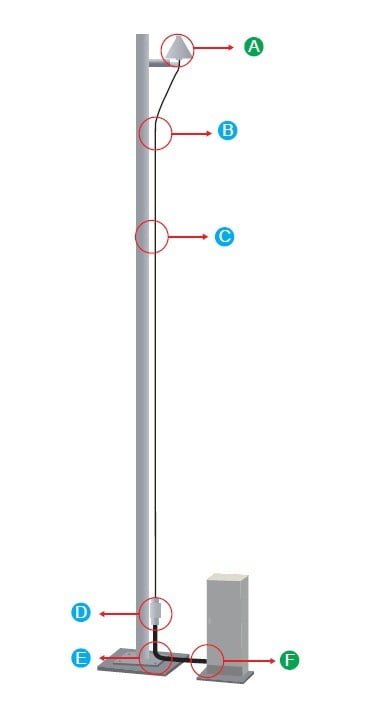
Accessories
A. GPS Antenna
F. Surge Arrester
Transmission Line
B. GPS Jumper
C. Grounding Cable
D. RF Connector
E. Feeder
